Equine Nutrition Assignment » Effect of Nutrition on Young Stock
| ✓ Paper Type: Free Assignment | ✓ Study Level: University / Undergraduate |
| ✓ Wordcount: 3405 words | ✓ Published: 03 Nov 2020 |
Monitor growth rates in foals, weanlings and young horses. Outline the factors that affect bone development. Describe common DOD’s. Outline the processes involved in healthy hoof growth and horn production.
Introduction
The start of a foal’s life strongly determines the produced outcome. In order to achieve successful foal or young stock production, it is important that we understand the needs of the foal.
Genetics, environment and nutrition are 3 of the most important factors in determining their individual growth patterns.
Through knowledgeable breeding we can to a point, control the genetic make up of the foal. What a mare lacks we can find perhaps in the sire and vice versa. We can also use genetics to compliment and accentuate each other, hoping to make the desired horse. This genetic potential as it is called, is inherited from the sire and the dam and it mainly relates to the overall shape of the lifetime growth pattern and the mature size of the animal.
Through a safe and healthy environment, we can control the mare’s 340-day gestation period ensuring that the mare can deliver a healthy young foal. She won’t need specialized prenatal care for the first 8 months, but the attention she will need for the last 3 months of gestation are critical to both her health and that of her foal. It is very important at this point to give her the best possible health, welfare and nutrition, including vaccinations and parasite control that we can.
With the correct understanding of nutrition of the young stock, we can control its growth and development. Their nutritional start has a substantial effect on their health and conformation into their maturer years.
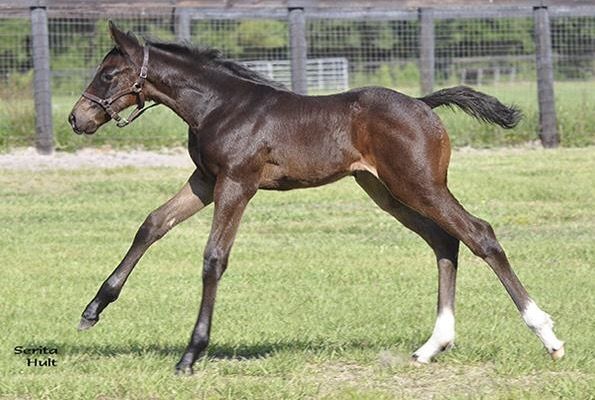
Fig.1. Thoroughbred Foal
Growth Rates in Young Stock
The optimal growth rate we aspire to achieve should result in a desirable body size at a target age. We also need to be able to accomplish this without compromising the foal and without creating developmental issues.
This is usually driven by the commercial endpoint and indeed, does not affect certain markets as much. However, in order to accomplish this, we need to understand what the intended horse is and for a particular purpose. Foals that are produced to be sold as weanlings, need to look big and strong to achieve good prices. Foals produced to be sold as yearlings however aren’t put under the same pressures.
Our main aims should be to achieve a steady weight growth rate, avoid sudden growth spurts and prevent excessive weight gain. Their growth should maintain an even and upward curve up until maturity usually at five years of age. This will help to avoid sudden growth spurts that can then put extra pressure on their joints, leading to poor conformation or soundness. Forced growth and an oversupply of carbohydrates will jeopardise the foal’s health and can be harmful to their physical development. Equally a sudden decrease in energy or protein intake can also contribute to DOD’s. This can often happen at the early weaning stage when the foal is suddenly deprived of the mare’s milk.
Weigh tapes and scales can be used to observe the progress of the foal and a developmental chart should be kept, noting the intended and average developmental gain for a foal of its age and type. Body weight, wither height, body length, and cannon circumference are some of the more commonly used measures of growth for horses. Each of these measures have a different pattern of growth, based on the types of tissues within that part of the body and the nutrients being supplied.
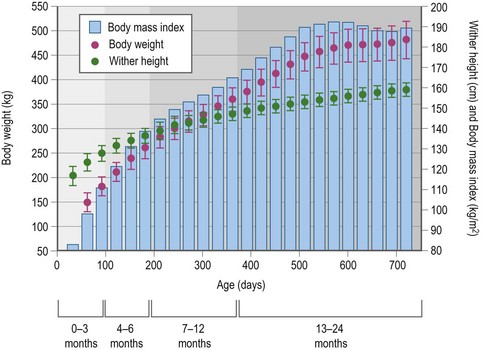
Fig.2. Growth Chart
Feed Stuffs for Foals & Young Stock
As are the last 3 months of the foal’s gestation the most impactful on growth in the womb so too are the first 2 years of their life. A healthy foal can grow up to 90% or more of its full adult size in these starting years, putting on as many as 3lbs per day.
Correct feeding and balanced nutrition therefore are essential for their growth. Mare’s milk is the most important nutritional resource for foals during the first months. For the first 36 hours it will provide the anti-body rich colostrum that helps protect it from disease and after that the huge volume of calories, fats and protein needed for their rapid growth.
Proper nutrition of the mare during gestation, will ensure that you have given her vital minerals such as iron, zinc, copper, manganese, selenium and vitamins A and E to pass onto the foal through lactation without depleting her of her own sources. Without these being available to the foal, it may succumb to bone developmental disorders.
A healthy well-conditioned mare will produce optimum protein, fat and sugar levels in milk thus encouraging correct growth rates of the foal. Higher amounts of fat will be produced by overweight mares, compromising the level of proteins. And on the other hand, and underweight mare will compromise both the fat and protein levels of milk which will affects the growth rate of foals.
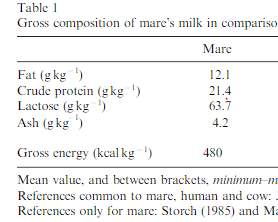
Fig.3. Nutritional Composition of a mare’s milk
After approximately 3 months of lactation, the mare’s milk is no longer adequate to meet the foal’s nutritional requirements and the it’s digestive system slowly loses the ability to be able to digest the milk as effectively. From the early on, the foal will show curiosity in hard feed and it is a good idea to introduce foal pellets. Its natural curiosity will encourage it to nibble and taste small amounts of feed this will slowly develop the hind gut and the youngster learns to eat concentrate feeds.
Foal pellets and other high-quality grains and forage that are added to the foal’s diet can be used to achieve quicker weight gain. It is essential the ration be properly balanced with vitamins and minerals. Deficits, excesses or imbalances of calcium, phosphorous, copper, zinc, selenium and vitamin E are of particular concern in the growing foal. Improper amounts or ratios can lead to skeletal problems.
As a rule of thumb, a foal should be fed 1% of its body weight per day.
Weaning
At approximately 6 to 8 months the foals are generally weaned from their mothers, at this stage they weigh about 250kg and will be eating between 2-3% of its body weight in feed i.e. 2.5 kg a day.
As weaning can be a time of increased stress, the foal can lose considerable weight. Environmental stresses, sudden weight losses and rapid weight gains can all contribute to DOD’s. Therefore, it is important to observe its body condition and eating habits before you address weaning and be confident that they are eating well before you proceed.
The quantity of protein enriched grain may need to be increased at this stage to make up for the loss of mare’s milk.
From weaning to 2 years old a horse will continue to grow at an incredible rate. They will continue to build muscle and bone rapidly therefore a high protein diet is necessary. At this stage they will need a diet containing 14-16% protein as well as high energy rations to be able to meet the demand for growth and activity.
A rule of thumb is to provide 60-70 % of the ration as concentrates and 30-40 % of the ration as roughage – measured by weight. The diet must also provide sufficient fibre to keep the digestive tract moving effectively to avoid any build up that could lead to gut pain and possibly colicing.
Feed merchants such as Red Mills and Gain produce complete feeds which contain a balanced ration suitable for foals and yearlings. They are purposely formulated to meet the requirements of growing young stock.
RED MILLS – Foal & Yearling Cooked Mix
|
RED MILLS – Foal Pellets |
Formulated for foals and yearlings to encourage sound growth and development. Concentrated feed with high protein levels for excellent muscle development. Fully balanced for vitamins and minerals for sound bone development. Range of cooked cereals for palatability and digestion.
|
||||||||||||||||||||
|
Formulated for foals to encourage sound growth and development. Fully balanced for vitamins and minerals for sound bone development. Highly palatable formula. Promotes topline and condition in the young horse
|
Factors that Affect Bone development
Thoroughbreds and other light breeds will achieve 84% of their mature height at the age of 6 months old. Therefore, a weaning intending to achieve 16 hands, will approximately stand at 13,2” by this stage. At 12 months it will approximately be 15 hands achieving 94% of its adult height and by 22 months it will have almost reached 97% of its full height standing at 15,2”. This rapid growth succession demands huge growth efforts on behalf of the skeletal make-up of the horse.
Bone is a dynamic tissue always adapting to change in its nutritional and physical environment. Within the bone, there a many different compositions. The area mainly responsible for growth is the physes or the growth plates. They allow for the longitudinal extension of the bone enabling the horse to grow vertically and achieve its optimum height and form his structural conformation. This process is called ossification. In the growing foal, the diaphysis and epiphyses are centers of ossification. It is here where soft cartilage cells are transformed into hard bone cells thus growing the bone.
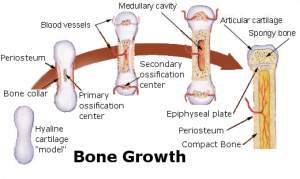
Fig.4. Bone Growth in the Maturing Horse
The strength of bone is derived from a mineralized cartilage framework. It responds to changes in the amounts of essential vitamins and minerals in the horse’s diet. Calcium and phosphorus comprise of 70% of the mineral content of bone while magnesium, copper, zinc manganese, vitamins A and D and other nutrients make up the rest.
Feeding the brood mare particularly in the last trimester with a balanced diet will ensure that the foal receives all the adequate nutrients and minerals for good health, a strong skeletal make-up and a healthy immune system. It is also important to make sure the quality of milk produced is good enough to feed the foal in the first few months.
Following on from that feeding the foal with a balanced ration and good quality forage they will attain all the essential amino acids, vitamins and minerals that they need to help promote good bone and hoof growth.
Exercise is also imperative to the development of bone. Providing a foal with regular turn out and exercise will assist in the laying down of periosteal bone in the cannon bones and other long bones and ensure future resilience and durability. Light exercise will train the skeletal tissues including ligaments, tendons and muscles to accept weight bearing forces imperative to healthy development of the skeletal system and bone conformation.
Once in training, the appropriate level of exercise should stimulate bone tissue, improve skeletal strength, and, in theory, reduce the probability of exercise-associated skeletal injuries. However, as bone is a dynamic tissue, long breaks from training can decrease bone mass and strength and leave the skeletal system vulnerable to DOD’s.
A horse will not achieve its maximum bone mineral content (BMC) until it is 6 years old. Therefore, it is vital that we take the necessary steps to healthy bone formation to avoid DOD’s and injuries. We need to provide a balanced feed and a suitable exercise regime which will ensure good strength and resilience of bone to withstand the activity level it is required for.
Nutrition
Nutrition plays a vital role in the healthy composition of bones and joints. It can have a huge impact on the musculoskeletal health, disease prevention and the future performance of horses. The growing foal passes through three important nutritional phases: nursing, creep feeding, and weaning. Nursing is completely dependent on the dam’s milk and should meet all the foal’s nutritional needs until he reaches approximately two months of age. As this quality and quantity wane, creep feeding is needed to supplement the nutrients that may no longer be available in the desired amounts. At this stage, creep feed should contain approximately 14-16% crude protein, 0.7-0.9% calcium, 0.5-0.6% phosphorus, 50-90 ppm (parts per million) copper, and 120-240 ppm zinc.[1]
Weaning then must provide all the nutrients the growing horse needs through good quality forage and concentrate feeds. Concentrates should be directly formulated for the growing horse and should contain approximately 14-16% crude protein, 0.8% calcium, 0.5% phosphorus, 50-80 ppm copper, and 100-200 ppm zinc.[2]
As necessary as it is for foals to receive all the nutrients required by the rapid growing body so too must they receive them in adequate amounts. The ratios of certain nutrients can have a knock-on effect on others therefore they must receive the proper ratios between nutrients to ensure successful bone development.
Water
Water is a vital nutrient and without it a horse could colic, dehydrate, and even die. Horses’ water requirements depend greatly on their physiologic state – a foal will consume most of its water whilst suckling from the nursing mare, however, whilst a weanling must learn to drink from the available fresh water supplies.
Calcium
While calcium is imperative to bone growth, excess calcium in the diet can inhibit the absorption of phosphorus in the body. So, while a diet might appear to have an adequate amount of phosphorus, it may not be fully available if the calcium levels are too high. Imbalances in phosphorous whether they are excessive or deficient can lead to osteochondrosis, a DOD that affects the cartilage formation in bone.
The correct ratio a foal should receive of calcium and phosphorus is 2:1.
Calcium should make up .8% of a weanling’s dry matter intake, and .5% of a yearling’s dry matter intake. Phosphorus should make up .5% of a weanling’s dry matter and .3% of a yearling’s dry matter.
Other nutrient imbalances of zinc, iodine, and copper can also be problematic during growth phases in foals.
Copper
Copper is needed for bone collagen and elastin synthesis. It should be readily available through feed however because it is a mineral that can be stored in the liver it is vital that the mare receives adequate supplies of it during gestation so some can be passed onto the foal prior to birth. As it is vital for bone formation, inadequate supplies can also to osteochondrosis and other DOD’s.
As calcium can inhibit the uptake of phosphorous so to can zinc inhibit copper however sufficient supplies of zinc are still necessary for enzyme functions.
Developmental Orthopaedic Diseases
Developmental orthopedic disease (DOD) is a term used to describe all musculoskeletal problems in growing horses. They are usually caused when ossification or when cartilage fails to mature and develop into bone leaving the system compromised and susceptible to issues.
DOD’s can be caused by several different environmental or management factors; trauma, rapid growth, imbalanced nutrition and stress on the musculoskeletal system caused by inappropriate exercise or obesity can all aid the development of orthopedic diseases. We may also have to consider the breeding or genetic makeup of the horse. Clinical signs of DOD’s may include pain, stiffness or lack of suppleness in gait, lameness, and or decreased mobility of the animal.
Developmental orthopedic disease can occur anytime between birth and 1½ years of age. They include physitis, osteochondritis dissecans, subchondral bone cysts and flexural limb deformities.
Physitis or Epiphysitis
Inflammation of growth plates at the ends of the long bones. This can cause lameness in an animal and show up as an inflamed region between two bones.
Osteochondrosis (OCD)
A cartilage disorder characterized by the presence of large flaps of cartilage or loose cartilaginous bodies within a joint. This can later progress to osteochondritis dissecans (OCD).
Subchondral Bone Cysts
Saclike cavities in bone beneath the cartilage surface that are filled with fluid or soft material.
Flexural Limb Deformities
Caused when the functional length of the tendon is not sufficient to maintain the limb in its normal extension i.e. contracted tendons. They can be congenital i.e. develop in the womb or developmental due to incorrect exercise. Box rest, splinting to support the limbs and even surgery may be needed depending on the severity of the condition.
Angular Limb Deformities (ALD)
Visually a more obvious DOD to the eye. This is where the limbs deviate from the normal weight-bearing axis. They can be congenital also or developmental due to over feeding and putting the unossified bone under too much pressure and causing it to malform.
Cervical Vertebral Malformation
A compression of the spinal cord or an instability caused due to incorrect growth. This can lead to neurological reactions which we refer to as “wobbler’s”.
Healthy hoof growth and horn production
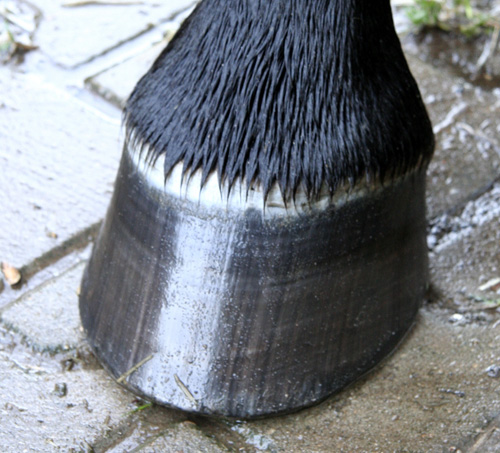
Hoof quality is determined by several factors including genetics, environment, and nutrition.
Some horses inherit weak hooves, and that can’t be changed. But proper care and nutrition can help a horse develop and maintain the best hooves genetically possible.
Several nutrients can influence hoof growth and quality. A well-balanced diet will typically contain the nutritional elements needed for optimal hoof growth.
Some key nutrients which can impact hoof health include:
Protein
The hoof structure is primarily made of keratin, a protein. Proteins are made of amino acids and are necessary for healthy hooves and growth. Methionine, an essential amino acid, is thought to be important for hoof quality. However, balance is key; if fed in excess, methionine is also believed to cause a depletion of iron, copper, and zinc. This can lead to crumbling horn and white line disease.
Fat
A diet with adequate levels of fat can be beneficial to the hoof, as fats can create a permeability barrier which can help prevent bacteria and fungi from entering the hoof horn.
Zinc
Zinc is necessary for normal keratinization of the hoof.
Calcium and phosphorous
Calcium is essential for proper cell attachment in the hoof horn and wall. However, ensure you’re feeding your horse the correct ratio of calcium and phosphorous. Excess phosphorous can block the absorption of calcium, leading to weak and abnormal bones.
Selenium and vitamin E
Selenium and vitamin E are important antioxidants protecting cell membranes. However, the balance of intake is crucial because selenium toxicity can cause hair loss, coronitis, and coronary band bleeding, as well as sloughing of the hoof and laminitis.
Biotin
Perhaps the most researched vitamin for hoof growth, biotin is thought to help with hoof integrity as well as coat, mane, and tail growth.
Examples of Supplements to promote healthy hoof growth
|
|
Biotin is the most critical vitamin in the process of hoof growth and formation. It is a member of the B vitamin family and is water soluble. Regular supplementation is encouraged if the horse has poor hoof quality. |
|
|
Farrier’s Formula is a pelleted hoof supplement that can be added as a top dressing on the regular feed or given separately. It provides nutrients such as phospholipids, omega fatty acids, vitamins, minerals, and important amino acid “protein building blocks”. These nutrients enable horses to build strong connective tissue proteins important for healthy hoof structure and growth. |
Conclusion
There isn’t a “one diet that cures all” when it comes to developmental orthopaedic disease. Feeding the pregnant mare properly, then continuing that well managed feeding for each individual is the best way to try avoid DOD. Giving the young stock a well-balanced diet and sufficient exercise will definitely help in promoting good bone formation, regular farrier visits will also promote good hooves and hopefully prevent any issues that could arise in the future.
List of Illustrations
Fig.1. Thoroughbred Foal
https://i.pinimg.com/originals/9f/30/a5/9f30a517ef49a8a7308774456fa0e6a6.jpg
Fig.2. Growth Chart
https://veteriankey.com/feeding-the-growing-horse/
Fig.3. Nutritional Composition of a mare’s milk
Fig.4. Bone Growth in the Maturing Horse
https://www.farmstable.com/blog/more-about-bone-development-in-horses/
Bibliography
- https://www.lifedatalabs.com/products/equine-hoof-coat-supplements/farriers-formula
- https://www.horsehealth.co.uk/images/HH_0214_041.jpg
- https://thehorse.com/137437/hoof-supplements/
- https://thehorse.com/19448/horse-hoof-health-and-nutrition-balance-is-key/
- https://thehorse.com/125043/feeding-to-avoid-developmental-orthopedic-disease-dod/
- https://www.triequestrian.ie/
- https://veteriankey.com/feeding-the-growing-horse/
- https://ker.com/equinews/training-and-bone-development/
- https://veteriankey.com/feeding-the-growing-horse/
- https://www.farmstable.com/blog/more-about-bone-development-in-horses/
- https://thehorse.com/14874/dod-developmental-orthopedic-disorders/
- https://thehorse.com/150700/feeding-foals/
[1] https://thehorse.com/150700/feeding-foals/
[2] https://thehorse.com/150700/feeding-foals/
Cite This Work
To export a reference to this article please select a referencing stye below:
Related Services
View allDMCA / Removal Request
If you are the original writer of this assignment and no longer wish to have your work published on UKEssays.com then please click the following link to email our support team:
Request essay removal






